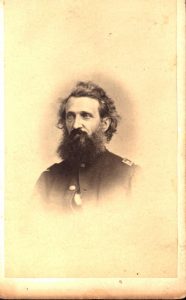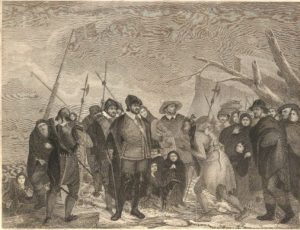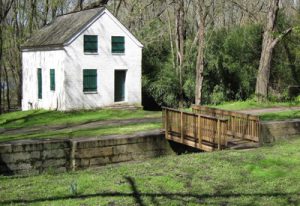A Casualty of Red Tape and Colonel Mosby

(Authors Collection)
As a collector of Civil War images I can’t say what it was about this particular image that jumped out at me when I purchased it some ten or twelve years ago. The CDV had been identified was Elijah Hobart, a Captain in Company B, 93rd New York Infantry, who was dismissed from the service in July 1862. There’s nothing remarkable about the simple bust view and perhaps, having been dismissed so early in the war, nothing remarkable about his service. He certainly did not fit within the scope of my collection (primarily eastern Ohio and West Virginia images) but something about this grizzled, wild-haired guy spoke to me. There had to be more to his story.
Elijah Fearing Hobart was a man of good stock. Born in coastal Massachusetts, both of his grandfathers had fought in the Revolutionary War. He moved to Boston as a child to apprentice the trade of engraving. Gaining some acclaim for his work – most notably a copy of ‘Landing of the Pilgrims’ – Hobart removed to Albany, New York where he worked on engraving bank notes.
With the outbreak of the Civil War, Hobart recruited a company for service in the famed Berdan Sharpshooters. The company was filled and accepted for service in November 1861, but unable to supply to appropriate arms for Berdan’s service the company was instead assigned to the 93rd New York Infantry, known as the “Morgan Rifles,” in honor of New York Governor Edwin Morgan. Apparently there was some dissatisfaction in the company, the enlisted men believing Hobart had promised them Sharps rifles and service as sharpshooters.
The regiment departed New York in March 1862, bound for the Virginia Peninsula. Upon arrival, the men of Company B laid down their arms, feeling they’d be duped. The company was placed and guard and Hobart placed under arrest, both released the next day only by the grace of General McClellan’s advance up the peninsula. Hobart would guide the unhappy company through the battle at Lee’s Mills, the siege of Yorktown and the battle of Williamsburg. On May 19, 1862 the regiment reached White House Landing and were detailed to provost guard duty.

While the regiment was stationed at White House Landing Hobart was detailed to transfer some Confederate prisoners to Fortress Monroe. Upon reaching the fort, Hobart was there detailed to transfer the prisoners to far off Fort Delaware at Pea Patch Island near Wilmington, extending his trip by several days and ostensibly being considered ‘absent without leave’ back at headquarters. Upon returning to his regiment he was again placed under arrest and on July 22, 1862 would receive papers officially dismissing him from the US service on charges of being absent from the company without leave. Hobart would appear to have been a casualty of red tape and miscommunication. He would try for several months to clear his good name without luck.
His military career apparently over, Hobart returned to the engraving business. Settling in Washington, DC, he took a job in the Treasury Department, overseeing the engraving of the government’s fractional currency. Only July 04, 1864, Hobart, in company with some twenty Treasury Department employees, secured the canal boat Flying Cloud to take a pleasure trip up the C&O Canal to Harpers Ferry, West Virginia. None could have realized their holiday excursion would turn deadly.
Hobart and friends were likely unaware that at that moment Confederate General Jubal Early had fixed his advance down the Shenandoah Valley on Harpers Ferry. The Federal garrison abandoned Bolivar and the lower town, digging in across the Potomac River on Maryland Heights and destroying the B&O bridge behind them. Working in conjunction with Early, Colonel Mosby and his partisan command had determined to attack the small Federal garrison at Point of Rocks, Maryland several miles downstream from Harpers Ferry. At Point of Rocks Mosby could sever the vital lines of communication between Harpers Ferry and Washington, including telegraph, the B&O Railroad and the C&O Canal.
Marshaling some 250 men and a piece of artillery Mosby reached Point of Rocks on July 04. Occupying the village and nearby Paton island were approximately 250 Federal troops from the Loudon Cavalry and the First Potomac Home Brigade. In the face of Mosby’s advance the Federal troops on Paton Island withdrew to the mainland, removing bridge decking across the canal behind them. As Mosby’s men began to cross the river they removed planks from a nearby building, repairing the bridge just enough for the rest of the command to safely cross. With Confederates now on the wrong side of the river the Federal garrison quickly retreated, leaving Point of Rocks to Mosby’s fate.

The Flying Cloud had safely passed Point of Rocks prior to Mosby’s attack on its way to Harpers Ferry but was likely turned back before reaching its destination, Harpers Ferry then being under attack by Early’s Confederates. On the return trip the boat was approaching Lock 28 on the C&O Canal as Mosby’s attack was underway. With the sounds of battle now frighteningly close for the local residents, the lock-keeper had either abandoned the lock or refused to come out of his house, and without an operational lock the Flying Cloud was a sitting duck. Unsure of the crew and contents, Mosby’s men trained their shots on the boat. A few of the passengers tried to force open the locks while others fled the area.
Accounts of Hobart’s last moments vary. Some claim that Hobart refused to leave the boat or be taken prisoner and was summarily shot by Mosby’s men. Another account claims that Hobart turned to a fellow passenger saying “They have our range – jump, and I will follow,” but was shot from behind by Mosby’s men that had circled through the woods. All accounts seem to agree that he did not linger after the fatal shot. Hobart was likewise not the only civilian casualty that day, as eighteen year old Hester Ellen Fisher had been killed by a stray shot while observing the skirmish from her front porch. [i]
Mosby’s men liberated a supply of whiskey and cigars from the Flying Cloud before setting it aflame. The rangers likewise cut the telegraph lines, damaged the B&O tracks and burned the abandoned Federal camp. The action at Point of Rocks would come to be known as Mosby’s ‘Second Calico Raid’ for the fine clothing, linens and buntings that the rangers liberated from the shops and stores at Point of Rocks, the first calico raid having come a year earlier. Last year my colleague Kevin Pawlak related an interesting story from the Second Calico Raid here: “Moulded in the form of a spread eagle…”.

Elijah Hobart’s body was first interred nearby, but at the request of Secretary of War Edwin Stanton the body was disinterred and removed to his hometown of Hingham, Massachusetts. In the years following the war Hobart’s comrades from the 93rd New York would successfully petition that his dismissal from the service be better reflected as a resignation. He was remembered in the regimental history as “…a noble man, of many disappointments and trials, one who, if an uncompromising opponent, was a warm, unhesitating, uncalculating friend; who considered no sacrifice too great for one he loved, and who was generous, even to his enemies.”[ii]
Sources:
[i] Burr, Fearing & George Lincoln. The Town of Hingham in the Late Civil War. Hingham, MA. 1876. Accessed via Google Books
[ii] King, David H., A. Judson Gibbs & Jay H. Northup. History of the Ninety-Third Regiment, New York Volunteer Infantry, 1861 – 1865. Swain & Tate. Milwaukee, WI. 1895. Accessed via Google Books.